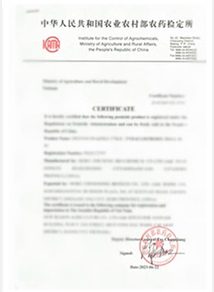
Sep . 10, 2024 17:09 Back to list
chlorothalonil 98%tc product
Chlorothalonil, a broad-spectrum fungicide, has gained significant recognition in agricultural practices since its introduction. Specifically marketed as 98% TC (technical grade), chlorothalonil serves as an effective defense against a variety of fungal pathogens that threaten crops, particularly in the fields of fruit, vegetable, and ornamental plant cultivation. With an emphasis on crop protection and agricultural sustainability, chlorothalonil plays a crucial role in ensuring food security and maintaining healthy agricultural ecosystems.
The chemical structure of chlorothalonil belongs to the class of compounds known as chloronitriles. Its mode of action involves inhibiting fungal cell respiration, ultimately leading to cell death. This unique mechanism of action allows chlorothalonil to target a wide range of fungal diseases, including leaf spots, blights, and molds. The versatility of chlorothalonil makes it an essential component of integrated pest management (IPM) programs, as it can be used alongside other practices to reduce the risk of resistance development in fungal populations.
.
When considering the environmental implications of chlorothalonil, it is important to note its relatively low toxicity to mammals and birds. However, concerns have been raised regarding its effects on aquatic life and potential accumulation in the environment. Consequently, regulatory agencies around the world have implemented guidelines to govern its usage, focusing on reducing off-target effects and promoting safe application practices. Farmers are encouraged to apply chlorothalonil in accordance with recommended guidelines to maximize its efficacy while minimizing environmental risks.
chlorothalonil 98%tc product

In recent years, the focus on sustainable agricultural practices has led to an increased interest in chlorothalonil as part of a broader approach to pest management. By integrating chemical controls like chlorothalonil with cultural practices, crop rotation, and biological control measures, farmers can achieve a more holistic approach to managing agricultural pests. The goal is to protect crops while preserving soil health and biodiversity, a crucial consideration in modern agriculture.
Research continues to explore the potential improvements in the formulation of chlorothalonil and its application methods. Innovations such as nano-encapsulation and targeted delivery systems are under investigation to enhance its efficacy and reduce the required application rates. These advancements not only promise to improve the efficacy of chlorothalonil as a fungicide but also contribute to more environmentally sustainable agricultural practices.
In conclusion, chlorothalonil 98% TC is a powerful tool in the arsenal of agricultural fungicides. Its wide-ranging effectiveness against fungal diseases, combined with ongoing research into more sustainable practices, positions it as a vital component of modern agriculture. As farmers and researchers continue to navigate the challenges of crop protection in an ever-changing environment, chlorothalonil remains an essential ally in the quest for sustainable and productive farming practices.
-
Insecticide Spirotetramat 11% + Thiacloprid 11% SC at Good Price
NewsJul.30,2025
-
Best Abamectin SDS - Premium Quality & Reliable Safety Data
NewsJul.29,2025
-
Agrochemicals Pesticides Solutions for Sustainable Farming
NewsJul.29,2025
-
High-Quality Tebuconazole Fungicide for Crop Protection at Best Price
NewsJul.29,2025
-
Chlorfenapyr 8% + Clothianidin 20%SC Pesticide Mixture for Effective Pest Control
NewsJul.28,2025
-
Best Azoxystrobin Difenoconazole Supplier for Crop Protection
NewsJul.28,2025
